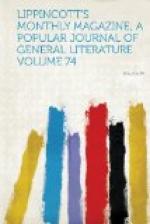When an American went to stay with Lord Palmerston at Broadlands, the great minister ordered horses for a ride in the delicious glades of the New Forest. When they came to the door his guest was obliged to confess himself no horseman. The premier, with ready courtesy, said, “Oh, then, we’ll walk: it’s all the same to me;” but it wasn’t quite the same. The incident was just one of those which separate the Englishman of a certain rank from the American.
There is of course a certain class of Americans, more especially among the jeunesse doree of New York, who greatly affect sport: they “run” horses and shoot pigeons, but these are not persons who commend themselves to real gentlemen, English or American. They belong to the bad style of “fast men,” and are as thoroughly distasteful to a Devonshire or Cheshire squire as to one who merits “the grand old name”—which they conspicuously defame—in their own country.
The English country-loving gentleman to whom we have been referring is, for the most part, of a widely different mould—a man of first-rate education, frequently of high attainments, and often one whose ends and aims in life are for far higher things than pleasure, even of the most innocent kind, but who, when he takes it, derives it chiefly from the country. Many of this kind will instantly occur to those acquainted with English worthies: to mention two—John Evelyn and Sir Fowell Buxton.
REGINALD WYNFORD.
THE FOREST OF ARDEN.
A girl of seventeen—a girl with a “missish” name, with a “missish” face as well, soft skin, bright eyes, dark hair, medium height and a certain amount of coquetry in her attire. This completes the “visible” of Nellie Archer. And the invisible? With an exterior such as this, what thoughts or ideas are possible within? Surely none worth the trouble of searching after. It is a case of the rind being the better part of the fruit, the shell excelling the kernel; and with a slight effort we can imagine her acquirements. Some scraps of geography, mixed up with the topography of an embroidery pattern; some grammar, of much use in parsing the imperfect phrases of celebrated authors, to the neglect of her own; some romanticism, finding expression in the arrangement of a spray of artificial flowers on a spring bonnet; some idea of duty, resulting in the manufacture of sweet cake or “seeing after” the dessert for dinner; and a conception of “woman’s mission” gained from Tennyson—
Oh teach the orphan-boy to read,
Or teach the orphan-girl to sew.
No! no! no! not so fast, please. In spite of Nellie’s name, of her face, of her attire, that little head is filled quite otherwise. It is not her fault that this is so: is it her misfortune? But to give the history of this being entire, it is necessary to begin seventeen years back, at the very beginning of her life, for in our human nature, as in the inanimate world, a phenomenon is better understood when we know its producing causes.




